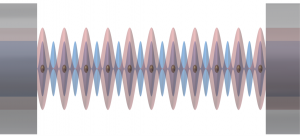Microscope Cavity QED
Spectral engineering of cavity-protected polaritons
in an atomic ensemble
Our paper, which presents the demonstration of spectral engineering of polaritons in a cold atom cavity system, has recently been published in Nature Physics on Mai 2, 2023. You can read the full paper by accessing it here: https://rdcu.be/dbmX7
In this study, we investigate the influence of strong cavity interactions on the protection of polartions against emitter inhomogeneities, hightlighting the role played by dark states in this system. Leveraging the cavity protection effect, we successfully engineer the spectrum of polaritons, resulting in the generation of polartions with muliple frequencies. This can lead to applications in quantum networks, particularly for shaping single-photon emission.
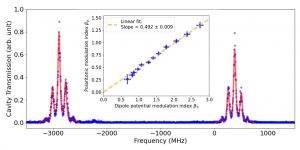
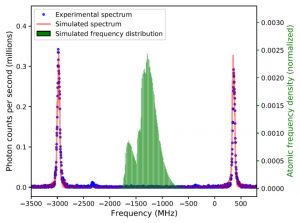
An optical elevator for precise delivery of cold atoms
We transport cold atoms from a magneto-optical trap inside the fiber cavity with an atom elevator. A dipole beam is vertically translated over 12 mm by using an acousto-optical deflector at the focus of a lens.
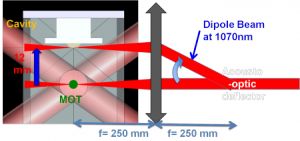
Overlapping two standing-waves in a microcavity for a multi-atom photon interface
We develop a light-matter interface enabling strong and uniform coupling between a chain of cold atoms and photons of an optical cavity. This interface is a fiber Fabry-Perot cavity, doubly resonant for both the wavelength of the atomic transition and for a geometrically commensurate red-detuned intracavity trapping lattice. Fulfilling the condition of a strong and uniform atom-photon coupling requires optimization of the spatial overlap between the two standing waves in the cavity. In a strong-coupling cavity, where the mode waists and Rayleigh range are small, we derive the expression of the optimal trapping wavelength taking into account the Gouy phase. The main parameter controlling the overlap of the standing waves is the relative phase shift at the reflection on the cavity mirrors between the two wavelengths, for which we derive the optimal value. We have built a microcavity optimized according to these results, employing custom-made mirrors with engineered reflection phase for both wavelengths. We present a method to measure with high precision the relative phase shift at reflection, which allows us to determine the spatial overlap of the two modes in this cavity.
Mapping standing-wave cavity modes with a commercial scanning near-field microscope tip
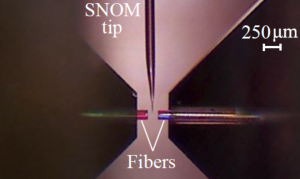
We describe a method to map the standing-wave pattern inside a Fabry-Perot optical cavity with sub-wavelength resolution by perturbing it with a commercially available scanning near-field optical microscope (SNOM) tip. The method is applied to a fiber Fabry-Perot microcavity. We demonstrate its use to determine the relative position of the antinodes at two different wavelengths. In addition, we use the SNOM tip as a point-like source allowing precise positioning of a microscope objective with respect to the cavity mode.
Mapping optical standing-waves of an open-access Fabry–Perot cavity with a tapered fiber, Francesco Ferri, Sébastien Garcia, Mohamed Baghdad, Jakob Reichel, and Romain Long, Review of Scientific Instruments 91, 033104 (2020) Review of Scientific Instruments 91, 033104 (2020) arXiv:1911.05134v1
Dual-wavelength fiber Fabry-Perot cavities with engineered birefringence
We have developed 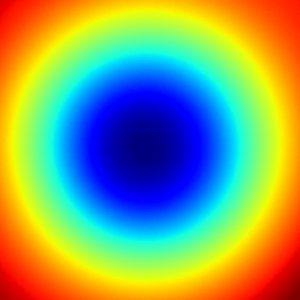 a method to engineer the frequency splitting of polarization eigenmodes in fiber Fabry-Perot (FFP) cavities. Using specific patterns of multiple CO2 laser pulses, we machine paraboloidal micromirrors with controlled elliptical shape in a large range of radii of curvature. This method is versatile and can be used to produce cavities with maximized or near-zero polarization mode splitting. In addition, we realize dual-wavelength FFP cavities with finesse exceeding 40 000 at 780 nm and at 1559 nm in the telecom range. We provide direct evidence that the birefringent frequency splitting in FFP cavities is governed only by the geometrical shape of the mirrors, and that the astigmatism of the cavity modes needs to be taken into account for specific cavities.
a method to engineer the frequency splitting of polarization eigenmodes in fiber Fabry-Perot (FFP) cavities. Using specific patterns of multiple CO2 laser pulses, we machine paraboloidal micromirrors with controlled elliptical shape in a large range of radii of curvature. This method is versatile and can be used to produce cavities with maximized or near-zero polarization mode splitting. In addition, we realize dual-wavelength FFP cavities with finesse exceeding 40 000 at 780 nm and at 1559 nm in the telecom range. We provide direct evidence that the birefringent frequency splitting in FFP cavities is governed only by the geometrical shape of the mirrors, and that the astigmatism of the cavity modes needs to be taken into account for specific cavities.
Dual-wavelength fiber Fabry-Perot cavities with engineered birefringence, Sébastien Garcia, Francesco Ferri, Konstantin Ott, Jakob Reichel, and Romain Long, Opt. Express 26, 22249-22263 (2018) Opt. Express 26, 22249 (2018) arXiv:1805.04089
Single Atom Register in an Optical Cavity
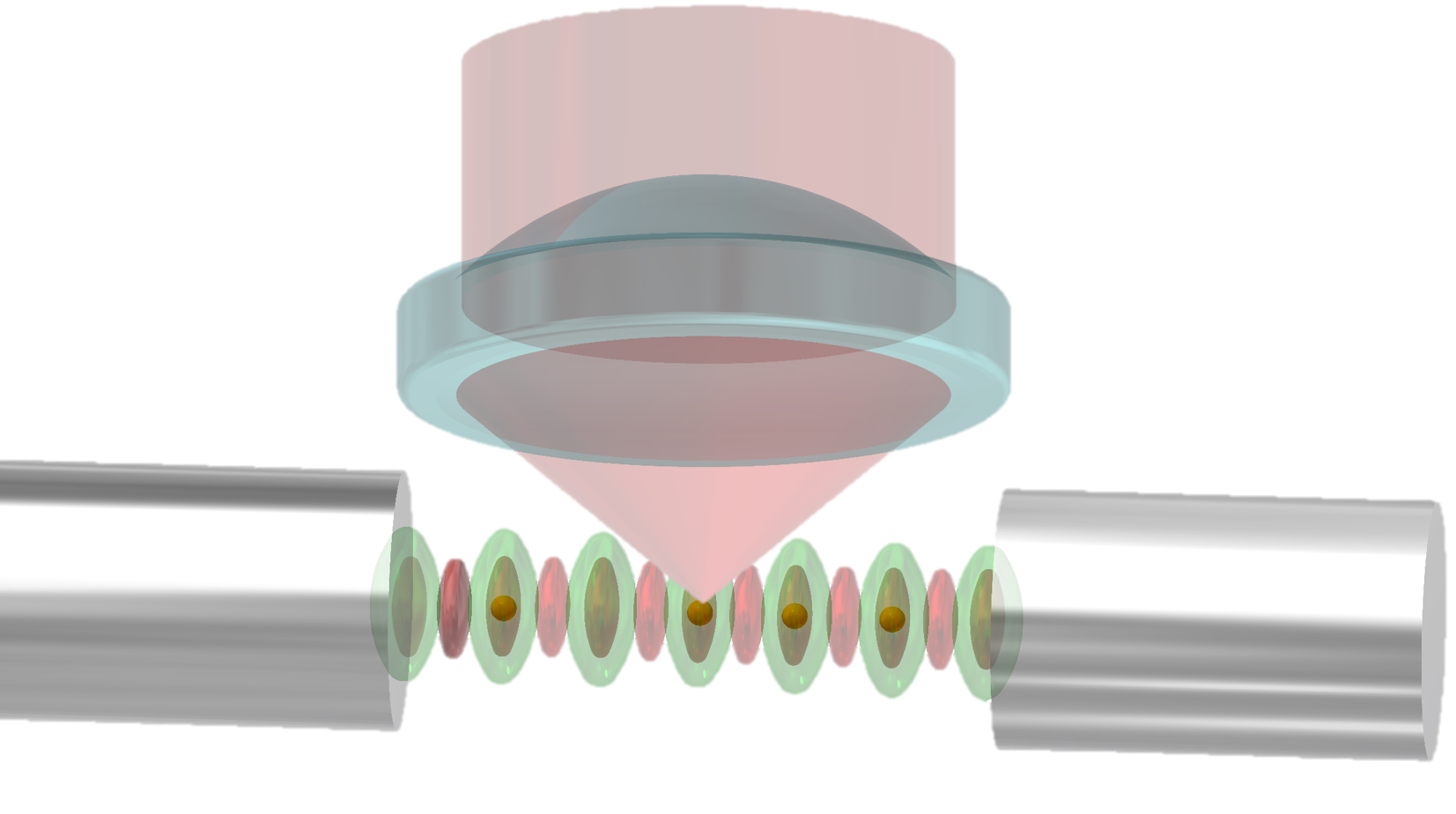 An exciting and fast‐growing research field has emerged at the interface of fundamental physics and technology, where the nonclassical features of quantum mechanics are employed to engineer powerful, radically new technologies. Apart from quantum cryptography – for which commercial systems are already available – quantum metrology is perhaps the one closest to real applications. High-fidelity control over light-matter coupling at the single-quantum level plays a prominent role in all quantum technologies.
An exciting and fast‐growing research field has emerged at the interface of fundamental physics and technology, where the nonclassical features of quantum mechanics are employed to engineer powerful, radically new technologies. Apart from quantum cryptography – for which commercial systems are already available – quantum metrology is perhaps the one closest to real applications. High-fidelity control over light-matter coupling at the single-quantum level plays a prominent role in all quantum technologies.
Only a small number of mechanisms are available so far to create the multiparticle entangled states that are the crucial resource of all quantum technologies. A “massively parallel” approach has given spectacular results in the last few years. Its idea is to use a high-finesse optical cavity to create an effective interaction that entangles the atoms. Entanglement experiments with such atomic ensemble CQED systems have enabled the production of spin-squeezed states, and have enabled observation of the Dicke quantum phase transition. By combining atom chip technology with the novel FFP microcavity – both developed in our group – we have been able to realize a miniature and robust platform for such experiments. This has enabled us to produce W states (a fundamental class of entangled states) and other multiparticle-entangled states enabling metrological gain. Using the exceptionally strong coupling of our FFP cavities, we have also developed one of very few quantum state tomography methods applicable to atomic qubits, which moreover provides single-qubit resolution in mesoscopic ensembles.
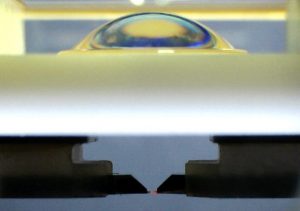 Motivated by applications in quantum-enhanced metrology, quantum simulation and quantum information processing, we are now building a new cold atom experimental platform devoted to multi-particle entanglement creation and characterization.
Motivated by applications in quantum-enhanced metrology, quantum simulation and quantum information processing, we are now building a new cold atom experimental platform devoted to multi-particle entanglement creation and characterization.
The goal of this project is to extend the generation of multi-particle entanglement to “mesoscopic” ensembles of neutral atoms (~100 particles), combining optical Cavity Quantum Electro-Dynamics (CQED) with quantum gas microscope techniques developed in the field of optical lattices.
Our setup will realize a single-atom qubit register inside an optical cavity, where each lattice site is strongly and identically coupled to the mode of a high-finesse optical cavity. The cavity allows creation of entangled states by the collective interaction of the atoms with the cavity mode, while a high-resolution microscope adds the capability to perform local operations on each atom of the register, opening the way for the generation and analysis of entangled states beyond the symmetric ones.
This system provides an ideal test-bed to investigate different methods for multi-particle entanglement generation and to study their fundamental limits. Quantum-enhanced metrology schemes can be explored and caracterized in this setup, in particular dissipative preparation of spin squeezed atomic ensembles [1]. This system can also realise an effective Dicke model, as proposed in [2] which exhibits a quantum phase transition, already observed for large numbers of atoms [3] [4]. With smaller atom number (10 to 50 atoms) we will be able to use quantum tomography techniques [5] to study the role of entanglement in the vicinity of the quantum phase transition as well as its scaling laws.
Experimental setup
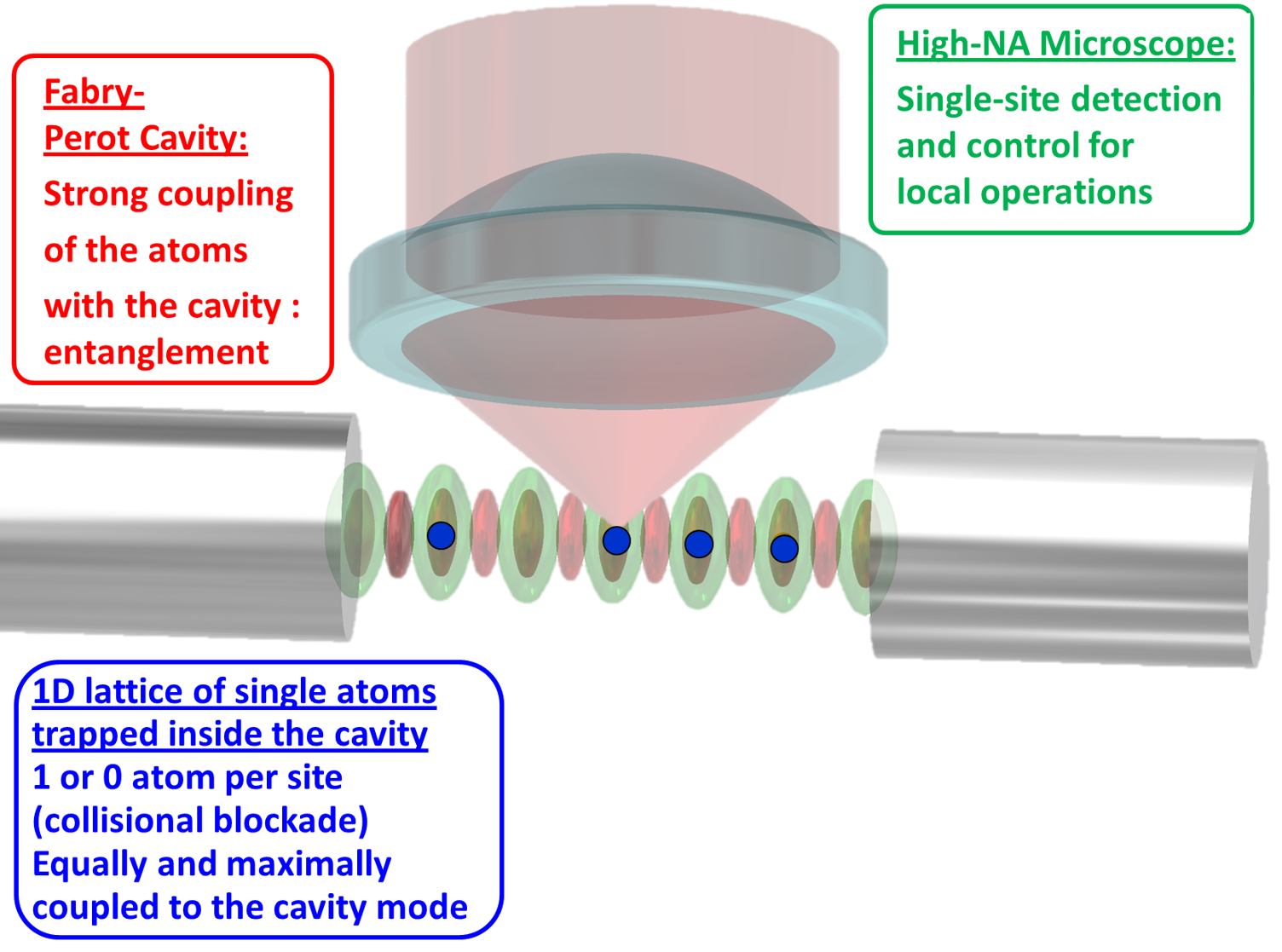 In our experimental setup, we are combining the following components :
In our experimental setup, we are combining the following components :
- At the heart of this experimental system is a new type of miniature fiber-based Fabry-Pérot (FFP) cavity developed in our group. This high finesse optical cavity is realized between two curved mirrors on the tips of two optical fibers facing each other (grey cylinders) and operates in the strong coupling regime of cavity QED. An intra-cavity 1D lattice (in yellow) at twice the resonant probe wavelength (1560 nm) ensures the trapping of no more than one atom in each site by collisional blockade, with an equal and maximal coupling of the atoms to the cavity probe field (in red).
- A high-resolution microscope, able to detect and address single atoms in the lattice. At the beginning of each experiment cycle, it provides us with an accurate measurement of the initial atom number. At the end of the cycle, it represents a powerful source of information for state analysis by detecting simultaneously the fluorescence of each atom. A focused laser combined with microwave transition will allow single-site resolved addressing.
- Transverse Raman beams (red arrows) will be added for cooling the atoms in the cavity to the vibrational ground-state. They will be used to perform two-photon Raman transitions assisted by the cavity between two stable atomic states. This will reduce the contribution to the losses of spontaneous emission, improving the quality of the states produced, as well as opening interesting new physical situations for creating multi-particle entangled states.
 This work has been supported by the ANR SAROCEMA project, grant ANR-14-CE32-0002 of the French Agence Nationale de la Recherche.
This work has been supported by the ANR SAROCEMA project, grant ANR-14-CE32-0002 of the French Agence Nationale de la Recherche.
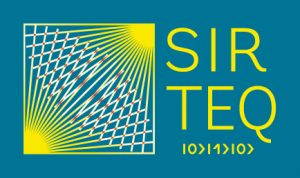 This work has been supported by Region Ile-de-France in the framework of DIM SIRTEQ
This work has been supported by Region Ile-de-France in the framework of DIM SIRTEQ

[1] E.G. Dalla Torre , Physical Review Letters 110 120402 (2013)
[2] F. Dimer , Physical Review A 75 013804 (2007)
[3] K. Baumann , Nature, 464 09009 (2010)
[4] M. P. Baden , arXiv:1404.0512v1 (2014)
[5] F. Haas , Science 344 180 (2014)

